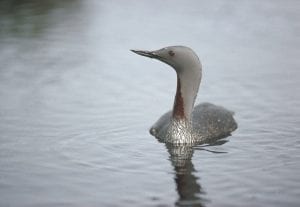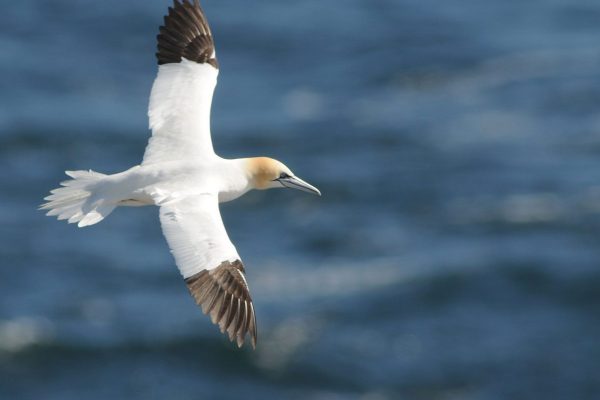
Gannet
| Irish Name: | Gainead |
| Scientific name: | Morus bassana |
| Bird Family: | Gannet |
amber
Conservation status
Conservation status
Status
Resident along all Irish coasts.
Identification
A large seabird with long, narrow wings. Plunge dives into the sea from up to 40 metres, folding wings back on descent to hit the water in a streamlined shape. Long neck, head and bill. Large projecting wedge shaped tail. Large dark webbed feet. In adult plumage is white both above and below with large dark wing tips and a yellowish head. Takes 4 years to reach adult plumage. Juvenile bird is all brown (apart from upper tail coverts), with beautiful fine white speckling. Attains adult plumage slowly with sub-adult birds showing white under sides and a variable amount of black in the wing.
Voice
Noisy at colonies, producing loud grating noises.
Diet
Fish
Breeding
Breeds in colonies on islands off the coast. The main Gannet colonies are located on Great Saltee, Co. Wexford, the Bull Rock, Co. Cork and on Little Skellig in Co. Kerry. A small colony is also found on Irelands Eye, Co. Dublin. Little Skelligs is by far the largest colony with over 26,000 nests and many thousands of additional non breeding birds in attendance. During the 'Seabird 2000' survey, the 26,000 nests recorded at Little Skellig, was an increase from 22,500 recorded at the time of the previous survey in 1984/5.
Wintering
Winters at seas, but can be seen in Irish waters throughout the year.
Monitored by
Breeding seabirds are monitored through breeding seabird surveys carried out every 15-20 years.
Blog posts about this bird

BirdWatch Ireland Nature Reserves to form part of Ireland’s first Marine National Park
BirdWatch Ireland is proud to partner with the National Parks and Wildlife Service (NPWS) and others in managing Ireland’s first Marine National Park – Páirc Náisiúnta na Mara, Ciarraí.
Announced on World Earth Day on Monday, April 22nd, the new National Park in Corca Dhuibhne, Co Kerry will unite some of Europe’s most ecologically valuable places across 70,000 acres of land and sea. These lands and waters provide extremely important nesting sites and food sources for seabirds including Red-listed species such as Puffin and Kittiwake and many other vulnerable Amber-listed species such as Manx Shearwater, Gannet and European Storm Petrel.
The Park will incorporate internationally important sites for seabirds such as BirdWatch Ireland managed Little Skellig and Puffin Island, as well as An Tiaracht Nature Reserve, which is managed by the Commissioners of Irish Lights.
It will also include new acquisitions by the National Parks and Wildlife Service (NPWS), such as the Conor Pass, the Owenmore River catchment, lands at Mount Brandon and the sand dune system at Inch Peninsula, along with sites already under State ownership, including the limestone reefs of Kerry Head Shoals and the waters around the Blasket Islands. The Páirc’s heritage legacy would be further enhanced by the inclusion of lands on the Great Blasket Island, the globally significant UNESCO World Heritage property of Sceilg Mhichíl, and Derrynane House, Historic Park and Beach, which are managed by the Office of Public Works (OPW).



Kittiwake. Photo: John Fox.
Páirc Náisiúnta na Mara, Ciarraí was officially launched in Dingle on World Earth Day, with Jill Crosher from BirdWatch Ireland’s Corca Dhuibhne (West Kerry Gaeltacht) Branch serving as a proud local representative of BirdWatch Ireland at the event. In light of the announcement, CEO of BirdWatch Ireland Linda Lennon said: “We are delighted to announce our partnership on the new Páirc Náisiúnta na Mara, Ciarraí. This area, including BirdWatch Ireland’s Puffin Island and Little Skellig Nature Reserves, provides vital breeding and feeding sites to some of our most iconic and endangered seabirds. At BirdWatch Ireland, we are strong believers in the power of collaboration when it comes to making real change for our birds and wider biodiversity. We look forward to embarking on this new journey with our partners the NPWS, the OPW and the Commissioners of Irish Lights.” Speaking at the launch, Minister of State for Nature, Heritage and Electoral Reform, Malcolm Noonan said: “With the iconic Conor Pass as the gateway, Ireland’s first Marine National Park brings mountains, blanket bog, heaths, rivers, coastal dunes, limestone reefs, sea cliffs and some of the wildest land and seascapes in the country together in celebration of nature. Alongside its seven sister parks, Páírc Náisiúnta na Mara, Ciarraí will be a flagship for the protection and restoration of these incredible places and the globally important array of wildlife that they are home to. The Páirc will also honour the island and coastal communities who live alongside it by ensuring that their unique tapestry of cultural and natural heritage is central to the future story of this special place.” Niall Ó Donnchú, Director General of the National Parks and Wildlife Service said: “Our new park is a celebration of heritage in all its forms. Our biodiversity and natural heritage sit layered in harmony alongside monuments and historic wrecks from many periods. This is a place of iconic significance and majestic beauty. At times, shrouded in mist as a far outpost, ethereal in its past, evocative in its firing of the imagination, and vital in its biodiversity. Undoubtedly, a place of local pride and universal value. We look forward to working with our partners, the Office of Public Works, the National Monuments Service, the Commissioners for Irish Lights, Birdwatch Ireland, Kerry County Council and the local communities to realise a truly world-class National Park.”
Gannet. Photo: Gerry Kerr.
Established in 1983, Puffin Island Nature Reserve off the southwest tip of Kerry is a summer home to many cliff- and burrow-nesting birds. As its name suggests, the island hosts many Puffins, with thousands of pairs of this Red-listed Bird of Conservation Concern nesting there every summer. The island also holds one of the largest colonies of Manx Shearwater in the country, with large numbers of Storm Petrel also breeding here. Fulmar, Guillemot and Razorbill are some of the many other species for which this site is important. Owned and managed by BirdWatch Ireland, Puffin Island Nature Reserve is already a Special Area of Protection (SPA) under the European Birds Directive and an Important Bird Area (IBA) as identified by BirdLife International. The inclusion of the reserve in Páirc Náisiúnta na Mara adds another layer of protection to this vitally important site for birds. The Little Skellig Nature Reserve is an iconic BirdWatch Ireland nature reserve famed for its colony of some 35,000 pairs of Gannets – the largest breeding colony in Ireland and among the largest in the world. There are also smaller numbers of Guillemot, Puffin and Kittiwake present. Both Little Skellig and the adjacent Skellig Michael are protected by a Special Protection Area, designated under the European Union Birds Directive. These islands also form one of Ireland’s Important Bird Areas. While seabirds are highly dependent on Puffin Island and Little Skellig in order to breed, they also rely on the surrounding seas as a food source so it is vitally important that they receive protection. The announcement of Páirc Náisiúnta na Mara, Ciarraí is a step forward for seabirds, and the many other species that share these habitats with them.
New protected area off Wexford coast is a step forward for vulnerable seabirds
The recent announcement of the new “Seas off Wexford” Special Protection Area (SPA) is certainly news to be welcomed.
For such a designation to be as effective as it can be, it is crucial that strong and effective conservation objectives and management plans are ambitious and that stakeholders are consulted throughout the process. It would be most welcome if the designation of new marine SPAs also led to a new vision for management of Ireland’s entire network of SPAs. BirdWatch Ireland calls on government to ensure that management plans are put in place for SPAs on both land and sea and that a whole-of-government approach is taken to implement them properly to safeguard the future of the birds they are intended to protect.
Minister for Housing, Local Government and Heritage Darragh O’Brien recently designated the new SPA of marine waters off the coast of Wexford which, at over 305,000 hectares, is the largest SPA designated in the history of the state. These waters provide extremely important food sources for seabirds, including Red-listed species such as Puffin, Kittiwake, Common Scoter and many other vulnerable Amber-listed species such as Fulmar, Manx Shearwater, Shag, Cormorant, Black-headed Gull, Lesser Black-backed Gull, Herring Gull, Roseate Tern, Red-throated Diver, Gannet, Common Tern, Little Tern, Sandwich Tern, Mediterranean Gull and Guillemot.




Kittiwake. Photo: Colum Clarke.
Under EU legislation, the Irish government has made a commitment to designate 10% of its waters as protected by 2025, and a total of 30% by 2030. This new designation increases the percentage of Ireland’s marine protected waters to 9.4%, just under the 2025 target. While this is certainly a step in the right direction, many questions remain, primarily, what will “protection” look like in practice? It is paramount that this is made clear in the soon-to-be-published SPA’s conservation objectives, which should detail the activities that will and will not be permitted in the SPA, among other measures. We look forward to reading them shortly. At the same time, BirdWatch Ireland in collaboration with BirdLife Europe and BirdLife International are mapping Ireland’s marine Important Bird Areas according to international and standardised BirdLife International criteria under a project funded by the Flotilla Foundation. This is an important time for our seabirds and it is welcome to see the government’s focus finally on setting out protected areas for them.
Red-throated Diver. Photo: Chris Gomersall
While the finer details about the Wexford SPA have yet to come to light, it is clear that certain activities will not be permitted in the Wexford SPA. The Minister has issued a Direction in relation to certain activities, which must not be carried out within or close to the SPA, unless consent is lawfully given. The listed activities are reclamation including infilling; blasting, drilling, dredging or otherwise disturbing or removing fossils, rock, minerals, mud, sand, gravel or other sediment; introduction or reintroduction of plants or animals not found in the area; scientific research which involves the removal of biological material; any activity intended to disturb birds; undertaking acoustic surveys in the marine environment and developing or consenting to the development or operation of commercial recreational/ visitor facilities or organised recreational activities.
Little Terns.
Together with our partners at Fair Seas – a coalition of Ireland’s leading environmental NGOs and environmental networks of which BirdWatch Ireland is a founding member – we have been calling for the government to meet their targets, but this alone is not enough. More action must be taken in order for us to adequately protect these important marine habitats and the many species that they support. Any move to better protect important habitats for birds is to be welcomed, and this is certainly no different. We are urging the Irish government to be ambitious in their plans for this new SPA and stress the need for focused community engagement in the surrounding areas. We also continue our urgent calls for the publication of the long-awaited Marine Protected Areas (MPA) Bill.







